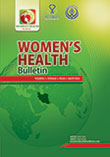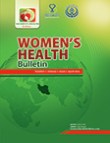فهرست مطالب

Women’s Health Bulletin
Volume:7 Issue: 2, Apr 2020
- تاریخ انتشار: 1399/02/16
- تعداد عناوین: 8
-
-
Pages 3-10Context
The decline in fertility rate is one of the most important social changes that has happened in human history. Given the paucity of research done in this regard, the present study aimed to review the relationship between gender equality indicators and fertility rate.
Evidence AcquisitionGender equity represent an important challenge for fertility research. Primarily, this paper briefly reviewed the research, conducted in certain countries, on gender roles and fertility followed by Gender Gap Index (GGI); because sudden change in population growth in countries led researchers to think about this issue. So searching the past and analyzing data in valid electronic databases, reviewing was done the concepts related to gender equality and population growth and fertility rate.
ResultsOur findings suggested that to increase fertility rate, gender equality should be achieved.
ConclusionsThe simultaneous attainment of gender equality and high fertility in any country is likely to be related to economic, social, cultural, religious, and familial conditions.
Keywords: Gender equality, Fertility rate, Population growth, Iran -
Pages 11-18Background
In developing countries, food insecurity is a serious problem associated with unplanned pregnancy. Very few studies have assessed the relationship between unplanned pregnancy and food insecurity. Therefore, the objective of this study was to examine this relationship in order to specify food insecurity determinants among Iranian women.
MethodsThis cross-sectional study was conducted on 700 postpartum women in Tehran city, Iran. The samples were selected from ten community health centers. Demographic, socio-economic, and food security status data were collected by questionnaire (including 18-item USDA questionnaire), and analyzed in SPSS software version 22 via Chi-square test, independent sample T-test, and Logistic regression.
ResultsA significant positive association existed between food security and family income (P<0.001, OR=0.994), education level of women (P=0.005, OR=0.211), home ownership (P<0.001, OR=3.099), ethnicity of Fars (P=0.009, OR=1.756), and planned pregnancy (P=0.035, OR=1.694). The association between food security and other variables (employment status of women and their husbands, family size, and age) was not significant.
ConclusionsUnplanned pregnancy among food insecure women was significantly higher than food secure ones. This indicates that women from food insecure household may need more family planning education and that families with unplanned pregnancy might require more support from the society or government in order to prevent food insecurity.
Keywords: Food security, Contraception, ethnicity, Socio-economic status -
Pages 19-25Background
Ankle sprain is one of the most common injuries in taekwondo fighters. This study aimed to investigate the effect of eight-week functional training on soft surfaces on the balance and electromyographic activity of the muscles of female taekwondo fighters.
MethodsIn this randomized field trial study conducted in Tehran, we selected 16 female taekwondo athletes and assigned them to experimental and control groups. The experimental group performed functional exercises on soft surfaces for eight weeks and three sessions per week. We collected the electromyography activity of muscles by a 16-Channel wireless Electromyography Model V 4.24 (Bayamed Company, Iran) in the biomechanics laboratory of the Allameh Tabataba’i University. Before and after the functional training protocol, we recorded the electrical activity of tibialis anterior, medial and lateral gastrocnemius, rectus femoris, and biceps femoris muscles of stance leg while performing Dollyo Chagi. We analyzed the data using ANCOVA at a significant level of P≤0.05.
ResultsEight-week taekwondo training on soft surfaces was significantly effective in reducing the Center of Pressure displacement (P=0.002 and P=0.045) and standard deviation (P=0.023 and P=0.022) concerning internal-external and anteriorposterior directions, respectively. Moreover, we observed an increase in the electromyographic activity of medial gastrocnemius muscle at 100 ms before foot initial contact (P=0.030).
ConclusionsThe results of this study showed that functional taekwondo training on soft surfaces was able to increase the balance of athletes and augment the feed-forward electrical activity of medial gastrocnemius muscle. Therefore, it seems that these exercises can be used to prevent ankle injuries in these athletes.
Keywords: Female, Martial arts, Electromyography, Postural Balance, Ankle -
Pages 26-32Background
Adolescence is a critical period of life for all people. Self-esteem is also a basic human need that affects one’s growth, development, and identity. This study aimed to explain 12-14 year-old female adolescents’ experiences regarding selfesteem.
MethodsIn this qualitative content-analysis study, adolescent girls aged 12-14 years were selected by the purposeful sampling method. The data were gleaned using individual interviews and focus group discussions. The recorded audio files were transcribed and the information was compared and merged with available related literature. The derived ideas were compared and the codes were integrated to form categories. Ultimately, we extracted more abstract categories and sub-categories.
ResultsThe concept of self-esteem in adolescents is defined as an intellectual approach to oneself. Adolescents considered perceived benefits and good feelings as the outcomes of high self-esteem. From their perspective, interpersonal and intrapersonal influencers contribute to self-esteem.
ConclusionsAttention should be paid to adolescents’ self-esteem and its effective factors, including interpersonal and intrapersonal influencers. Therefore, appropriate conditions should be provided for adolescents to promote their self-esteem.
Keywords: Adolescents, Self-esteem, Qualitative research -
Pages 33-42Background
Diabetes can be successfully controlled by metabolic, psychological, social, and interpersonal factors. The present study aimed to determine the effectiveness of family empowerment therapy based on self-compassion on self-care and glycosylated hemoglobin in female patients with type 2 diabetes mellitus.
MethodsIn a randomized controlled clinical trial with control group, pre-test, and post-test, 60 women with type 2 diabetes referred to the endocrinology department of Imam Hossein Hospital in Tehran province from December 2018 to April 2019 were randomly selected from the 73 patients narrowed down according to the inclusion criteria. Afterwards, they were randomly assigned to experimental and control groups. The experimental group (n=30) was treated with family empowerment therapy based on self-compassion for eight weekly 90-minute sessions while the control group (n=30) received usual hospital treatments. Data collection instrument was Summary of Diabetes Self-Care Activities; glycosylated hemoglobin measurements were performed in three phases of baseline, after intervention, and three-month follow-up and analyzed by multivariate repeated measures analysis of variance and Bonfroni post-hoc test using the SPSS-21 software.
ResultsThe results of repeated measures analysis of variance showed significant differences after the intervention between the experimental and control groups regarding self-care (P0.001=, F=561.086) and glycosylated hemoglobin (P=0.001, F=304.953); furthermore, comparison of the means indicated the effectiveness of the treatment in improving self-care and reducing glycosylated hemoglobin levels in the experimental group compared to the control group. Moreover, the Bonferroni test results showed that in the pretest stage, there was no significant difference between the two groups in terms of self-care (P=0.447) and glycosylated hemoglobin (P=0.887); however, in the post-test and follow-up stages, the two groups showed were significantly different concerning self-care (P=0.001) and glycosylated hemoglobin (P=0.001), implying the effectiveness of the intervention and the sustainability of its effects.
ConclusionsThe results of the present study revealed that family empowerment therapy based on self-compassion can be effective in improving self-care and reducing glycosylated hemoglobin in women with type 2 diabetes.
Keywords: Self-care_Type 2 diabetes mellitus_Family empowerment therapy based on self-compassion_Glycosylated hemoglobin -
Pages 43-48Background
In recent years, for the purpose of proper planning, the quality of life has been considered by researchers and clinical experts as one of the most important outcomes of chronic diseases. The aim of this study was to evaluate the quality of life and its dimensions in women and men with Human Immunodeficiency Virus (HIV) or Acquired Immunodeficiency Syndrome (AIDS) in the high-risk behaviors center of Shiraz.
MethodsIn this cross-sectional study, we selected 224 patients (112 man and 112 woman) with HIV / AIDS from Behavioral Counseling Center of Shiraz through convenience purposive sampling method; we gathered data using quality of life Short-Form 36 (SF36) and a demographic questionnaire. Data were analyzed using a t-test.
ResultsThe mean score of general health (55.31±17.82) (P=0.367), physical health (287.85±81.16) (P=0.168), and psychological health of women (255.40±74.80) (P=0.207) was more than those with HIV/AIDS. The mean score of other quality of life dimensions in women was more than that of men; however, no significant differences were observed in other dimensions.
ConclusionThe average score of quality of life in women was better than in men, hence the necessity of promoting calm adherence to treatment.
Keywords: Quality of life, Men, Women, HIV, AIDS -
Pages 49-55Background
Marital conflicts bring about issues in marital relationships and increase the divorce rate. Sexual skill training can prevent some of the marital conflicts and sexual problems in women. The present study aimed to investigate the effect of schema therapy on sexual self-esteem in the women involved in marital conflicts in Ahvaz.
MethodsThe study design was quasi-experimental. The study population comprised all women with marital conflicts who referred to the psychological centers of Ahvaz in 2019; using convenience sampling, we selected 30 women willing to participate in the project and randomly divided them into experimental (n=15) and control (n=15) groups. The research instrument included Marital Conflict Questionnaire (MCQ) and Sexual Self-Esteem Index for Woman-Short Form (SSEI-W-SF). The experimental group underwent eight sessions (90-minute sessions per week) of schema therapy. The follow-up was performed after 30 days. Data analysis was done using SPSS version 24.
ResultsIn terms of sexual self-esteem, there was no significant difference between the experimental and control groups in the pre-test stage. Schema therapy effectively increased sexual self-esteem in women involved in marital conflicts in the experimental group (P<0.001). The mean pre-test and post-test scores of the experimental group were 106.26±8.05 and 128.76±6.77, respectively, which increased compared to the pre-test (107.13±6.71) and post-test (108.46±8.97) of the control group.
ConclusionsSchema therapy can be employed to improve self-esteem in women involved in marital conflicts. In this way, the conflicts among couples and other family members can be reduced.
Keywords: Marital conflict, Sexual self-esteem, Schema therapy, Women


